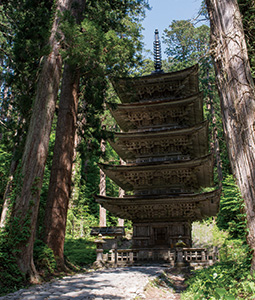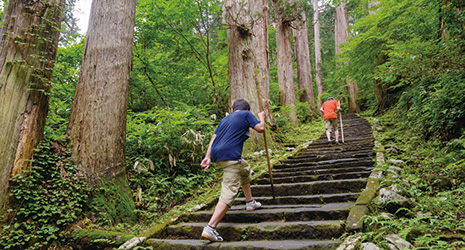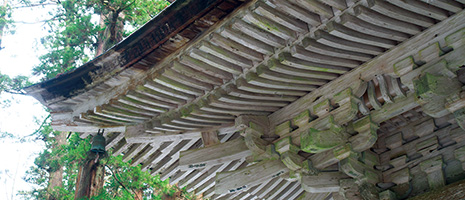
Five-storied Pagoda of Mount Haguro
- PREVIOUS
- NEXT
May 2020
A Five-storied Pagoda Among the Mountains of the Gods

The Dewa Sanzan in Yamagata Prefecture have been worshipped as holy mountains since ancient times. The wooden Five-storied Pagoda of Mount Haguro, built about 650 years ago among these mountains, presides among old cedar trees and offers peace to those who visit with its simple beauty in harmony with nature.

In Japan, where mountains make up three-quarters of the country’s land, mountain worship has been practiced since ancient times, with people revering mountains as sacred places where gods dwell. Shugendo, which combines mountain worship with religions such as Buddhism and Taoism from mainland Asia, originated in the Heian period (794–1185), and began to expand all over Japan. Rigorous spiritual training was practiced by ascetic mountain priests, known as yamabushi, on the mountains deemed sacred for Shugendo.
The Dewa Sanzan, or the Three Mountains of Dewa, which lie in the central part of Yamagata Prefecture, are among the representative sacred mountains. The Three Mountains of Dewa are Mount Haguro, Mount Gassan and Mount Yudono. Prince Hachiko, son of Emperor Sushun, is said to have undergone ascetic training here at the end of the sixth century, marking the beginnings of the worship of the Dewa Sanzan. The belief that one can gain happiness in this world at Mount Haguro, experience the world of the afterlife at Mount Gassan, and gain new life and be reborn at Mount Yudono, was developed here. This belief spread to many people via the yamabushi who traveled around the country, and by the Edo period (1603–1867), many worshippers made the pilgrimage to the Dewa Sanzan from all over Japan. The celebrated poet Matsuo Basho (1644–1694) left behind a haiku about Mount Haguro.
Suzushisa ya / hono mikazuki no/ haguroyama
Coolness– / the crescent moon faint / over Black Feather Mountain
— From Basho’s Haiku: Selected Poems of Matsuo Basho (Trans. David Landis Barnhill)
Standing at the base of Mount Haguro is the Five-storied Pagoda of Mount Haguro, a National Treasure. When Buddhism was brought over to Japan in the sixth century, pagodas were built in Nara and Kyoto, the capitals at the time, and construction of these pagodas spread across Japan along with Buddhism.

The Five-storied Pagoda of Mount Haguro is said to have been built in the tenth century, and it is thought that the current pagoda was rebuilt in 1372. The pagoda stands among a forest of cedar trees over 300 years old off to the side of the path that leads to the summit of Mount Haguro. The pagoda lies beyond the Zuishin Gate, the entrance to the Dewa Sanzan, and across the Harai River, where, in the past, worshippers would purify themselves. The pagoda is about 29 meters tall, and is very distinctive with its simple wooden construction that lacks colors or decorations.
Watanabe Sachi, curator of the Dewa Sanzan Museum of History, says, “The pagoda, surrounded by cedar trees, is truly in harmony with nature. Its white bark, exposed to wind and snow over many years, exudes a simple beauty.”
The pagoda is constructed from cedar and Japanese elm, and the wooden joints are stabilized with wisteria vine, which tightens over time as it dries. No metal nails are used. The five-layered roof is covered with many overlapping layers of thin cedar planks in a technique known as kokerabuki (shingling). The four corners of the roof slope gently upwards, and the eaves are deep. Another feature of the pagoda is the kumimono (“bracket complex”) that supports the deep eaves and protects the columns and walls from snow and wind. Kumimono, made by intricately combining multiple pieces of wood, not only strengthens the pagoda, but also lends it a decorative beauty.
More than one meter of snow accumulates in winter around Mount Haguro. Repairs have been repeatedly carried out on the five-storied pagoda, which has continued to stand even in such a harsh natural environment, and they continue to this day.
“I think that the pagoda has been preserved over many years precisely because of the deep faith held by the yamabushi and other visitors,” says Watanabe. “Some visitors spend a long time in front of the pagoda. Many say that they feel calm seeing the pagoda standing there surrounded by nature.”
The five-storied pagoda, standing among the mountains where gods dwell, quietly symbolizes the beliefs associated with the Dewa Sanzan and their deep historical connection with nature.
- PREVIOUS
- NEXT

